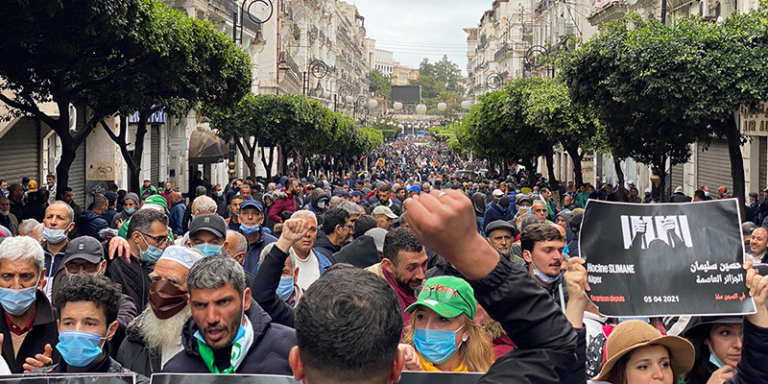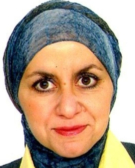
For the first time in its history, Algeria is experiencing a political uprising that began in 2019 and is characterized as inclusive, peaceful, popular, and resilient, with specifically political claims. Its resilience is proven by the return of popular demonstrations in February after almost one year of voluntary interruption. During the two years since this political confrontation began, the gap between the authorities and the people did not narrow. Indeed, the political crisis in the country is undeniable and its resolution appears to be protracted. President Abdelmadjid Tebboune and the political establishment consider the crisis to have been resolved with the resignation of former President Abdelaziz Bouteflika in 2019; however, members of the popular movement—the Hirak—consider the crisis as ongoing and deeply systemic. The difference in interpretation has great impact on how the crisis is managed and whether the political system will be able to address demands for a democratic transition.
One Crisis, Two Perceptions
Algerian President Tebboune adamantly repeats that Hirak’s main claims have been satisfied. He insisted on organizinga presidential election and on the drafting of a new constitution, and he called fornew parliamentary elections in June, all for the purpose of creating a “new Algeria.” However, the Algerian regime’s strategy to impose its agenda relies on constructing its own narrative of the Hirak—and more importantly, on its own definition of the crisis.
This narrative scheme is based on an equation that contrasts the so-called “original” and “blessed” Hirak with the “false” Hirak. The “original Hirak” saw millions of Algerians marching every Friday and Tuesday to ask only for the departure of President Bouteflika. In the official narrative, this earlier Hirak is where the fusion between the people and their army took root as a tangible reality. In this vein, on February 22, 2020, the Algerian government officially decreeda “national day of fraternity and cohesion between the people and the Army for democracy.”
The official narrative denies the existence of a structural crisis in the system, one that questions the legitimacy of the regime.
In fact, the official narrative denies the existence of a structural crisis in the system, one that questions the legitimacy of the regime. By doing so, the regime seeks to lay down the bases of a new political community in which the patriots are the “original Hirak” while the enemies are the “counterrevolutionaries” (that is, the continuing and actual Hirak on the ground). A government minister recently stated that the counterrevolutionaries “reject the will of people among the parties of narrow interests that are already ejected by the blessed popular Hirak that revealed their plans.” Therefore, the claims for a transition period are excluded from the government’s discourse. In reiterating his refusal for any transitional period in every meeting with the press, President Tebboune insists that the Hirak’s claims have been satisfied.
In line with Tebboune’s position, the Algerian People’s National Army warns against those who are plotting to destabilize Algeria and its institutions. The editorials of the army’s magazine accuse the Hirak of acting to destabilize the new Algeria. Recently, the magazine wrote that the movement is threatening the solidarity between the army and the people and is cooperating with “enemies of Algeria serving the Zionist agenda,” using the internet presumably to spread misinformation.
On the other hand, the Hirak’s original demand was to obstruct the automatic succession of Abdelaziz Bouteflika for a fifth term. However, if the original aim of the Hirak was only to prevent the continuation of an impotent president as the head of the state, it should have stopped in April 2019, when Bouteflika resigned. Instead, other slogans appeared, with the most famous being “They all should go.” This way, the popular uprising clearly identified the nature of its demands, consequently giving rise to the crisis facing the country at present.
“They all should go” asserts that the crisis is neither circumstantial nor an event or a sudden and brief accident. It is what can be identified as a crisis process. It is the consequence of many and cumulative dysfunctions in a multi-phase process, during which the beginnings of the crisis could have been identified. The Hirak is situated in a broad spatial and temporal context that integrates the complexity of its roots, incubation, constituents, development, and consequences. Undoubtedly, the incubation of the crisis was Bouteflika’s fourth presidency, when he became gravely ill, and this has weakened the presidential institution like never before. Tensions inside the decision-making process increased and economic difficulties worsened.
Nevertheless, the Hirak is not directed against one person, one function, or one event. It expresses the rejection of what Algerians call “the system.” Known academically and colloquially as le pouvoir, the system can be defined as the sum of all the persons, practices, and rules that have governed Algeria since its independence in 1962. On a deeper level, the system refers to the organization of the state in which the political regime, the economic structure, and the sociocultural organization are interconnected and complementary. The current crisis is a brutal rupture in this complementarity.
“The all should go” targets the way the decision makers govern, share roles, and decide and apply their decisions. Since 1962, the Algerian political system has been based on delimited roles between a deep invisible state that decides the strategy to follow and makes the arbitrations, on the one hand, and the visible façade that creates discourses and executes the decisions, on the other. Considering the crisis as a process means recognizing that traditional mechanisms of decision making and executing and sharing roles became not only inoperative, but also rejected. The Hirak claims to apply popular sovereignty in its approach.
One Crisis, Two Solutions: Institutional Normalization vs. Democratic Transition
Institutional normalization is considered a key pillar of the road map that was worked out since April 2019. The military establishment has adamantly rejected any transitional period as it would entail many risks. The proposed alternative that it endorsed contained the following steps. First was restoring the electoral process and organizing the presidential election in December 2019. Despite the fact that these elections occurred in a context characterized by the arrest of dozens of activists and a massive boycott, the military high command endorsed the electoral process so as to close the chapter of the vacancy of power since Abdelaziz Bouteflika’s resignation. More importantly, the elections allowed the army to erect a civilian façade without the consequence of having their role and weight in the Algerian political system called into question.
The second step was drafting a new constitution and organizing a popular referendum for its adoption. Aside from a very low general turnout, 23.7 percent, the new draft was adopted by only 66.8 percent of the vote. In reality, less than a quarter of Algerians actually endorsed the document that practically consolidates the authoritarian character of the military supported regime and grants the president even more influence than before, although it limits him to two terms in office.
Even though the election of a new legislative assembly does not present a major development, since the parliament is not a serious counter-power to the president, the legislative elections are useful to legitimize the regime.
Third, the upcoming legislative elections of June 12 are considered as the penultimate step before the one that closes the process: local election. Even though the election of a new legislative assembly does not present a major development, since the parliament is not a serious counter-power to the president, the legislative elections are useful to legitimize the regime. They will give it a new partisan class. By organizing these elections, the decision makers are convinced that the institutional floating of the system that has persisted since February 2019 will be resolved more rapidly. Such institutional normalization will be concluded with local elections.
As for the Hirak, its actions are not limited to demonstrations. Political parties, associations, and groups of intellectuals have produced several political propositions to manage the crisis, with regime change as the ultimate objective. Basically, all the propositions confirmed the need for a democratic transition, with more or less important similarities. These are related to balance of power perceptions, the acceptance (or not) of large multi-ideological alliances, and proximity to the regime.
The partisans of top-down transition defend this proposition for three reasons. First, they regard the regime as more resilient than the Hirak. Second, they believe in the regime’s ability to implement democratic reforms, as it did in 1989—although that was cut short by the military’s intervention. Third, they think that controlled reforms could prevent state instability due to sudden regime collapse. For an example, the partisans of this project rely on the Soviet experience of President Mikhail Gorbachev’s perestroika because of several similarities between the two systems: party control, strong elite, centralized decision making. Concretely, the “National Forum for Dialogue” coalition that was formed in July 2019 (also known as the “Ain Benian Platform”) defended a top-down transition as an essential part of its program. It proposed starting it with a presidential election, and it added several juridical and political conditions to guarantee the transparency of the election. Even if these conditions were not fulfilled in December 2019, most of the Ain Benian actors took part in the presidential election. Confirming their proximity to the resilient regime, they definitively left the Hirak.
The defenders of a bottom-up transition start from the assumption that the Hirak is a powerful and broad-based grassroots movement, one that seriously weakens the regime.
In contrast, the defenders of a bottom-up transition start from the assumption that the Hirak is a powerful and broad-based grassroots movement, one that seriously weakens the regime. They defend the idea that the persistence of popular pressure will force the regime to relinquish power, as happened in neighboring Tunisia. Created in June 2019, the Forces for a Democratic Alternative coalition espoused and continue to support this strategy. They remain engaged in the Hirak and refuse all contact with the government. They also boycotted the 2019 presidential election and the constitutional referendum; now they will not participate in the legislative poll. In fact, they affirm that the ruling military command is not ready to share power but wants to shape the opposition to its liking, as it always did. It is worth noting that the Democratic Alternative’s hostility toward the Hirak’s Islamist political forces prevents it from any popular growth. This coalition remains strictly limited to those activists with secular and leftist tendencies.
An Issue of Balance of Power
The democratic transition issue in Algeria is a matter of two types of balance of power. One is the face-to-face encounter between political rulers and Hirak forces. In this fight, the government decided to use tactics of dissuasion and repression, as well as patronage and elections, in order to avoid compromise. The second type of balance of power takes place inside both parties to the crisis. Actually, the restoration of stability, complementarity, and solidarity among the actors in the political system has not been achieved yet. Indeed, the signs of division are public, while contradictions exhibited by government actions and policies are only revealed by bloggers and influencers.
For its part, the Hirak did not produce the required political forces that could push the decision makers to accept the principle of democratic transition through a gradual process. Although it remains a constant source of pressure, the Hirak suffers from objective and subjective constraints that make more complex the emergence of new organized and influential political forces. In the meantime, the Hirak of the street continues while the army and the president remain good allies whose aim is to preserve the old system.
Photo credit: Twitter/Djaafar khelloufi

